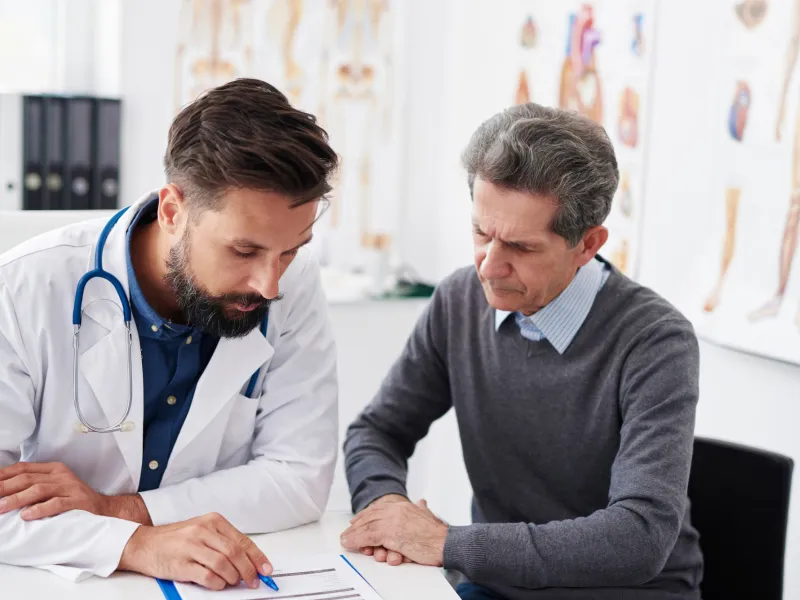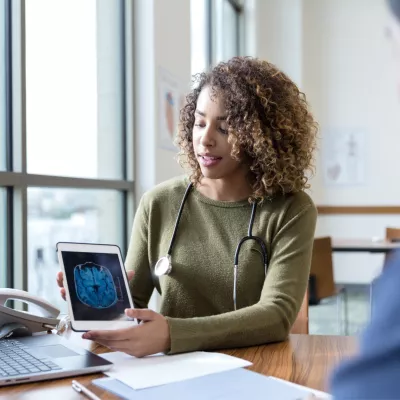
Expertise for All Movement Disorders
Life changes when you’re diagnosed with a movement disorder. You deserve personalized care to get back to the activities of daily living and support that extends beyond the doctor’s office. Here, you’ll find caring experts and state-of-the-art treatments to help you feel whole again.
We’ll get to know you — your daily life, habits, struggles and goals — and help you determine which treatments could meet your needs best. At each step of treatment and throughout your ongoing recovery, we’ll be by your side.
Treating Movement Disorders With Extraordinary Care
Movement disorders are conditions that affect your nervous system, causing either unintentional movements or slowed, intentional movements. Below are some of the many movement disorders our team treats.
-
Blepharospasm
Blepharospasm causes blinking or twitching of your eyelid and may cause your eyes to close entirely over time.
-
Dystonia
Dystonia causes excessive, involuntary muscle contractions that resemble tremors and can worsen with specific tasks.
-
Gait Disorders
Gait disorders are abnormal walking patterns. These conditions become more common as people age, in part due to weakened muscles, delayed reaction time and reduced muscle coordination.
-
Hemifacial Spasm
Hemifacial spasms are an involuntary movement of muscles on one side of your face. An abnormal blood vessel compressing a facial nerve is usually the cause.
-
Huntington’s Disease
An inherited condition, Huntington’s disease can affect areas of your brain associated with movement.
-
Opsoclonus-Myoclonus Syndrome
Opsoclonus-myoclonus syndrome is a rare movement disorder that can cause involuntary muscle jerking (myoclonus), rapid eye movements (opsoclonus) and uncoordinated movement (ataxia).
-
Parkinson’s Disease
Parkinson’s disease is a progressive brain disease that affects everyone differently. Common symptoms include bradykinesia (slow movement), gait and balance problems, limb rigidity and tremors.
-
Restless Leg Syndrome
Restless leg syndrome is a condition that causes an irresistible urge to move the legs. Though it most often happens at night, symptoms can occur during the day, especially when sitting.
-
Tardive Dyskinesia
Tardive dyskinesia, which has been linked to certain medications that help control dopamine, is a movement disorder that can cause movements (rapid or slow) in one or more parts of the body.
-
Tics
Tics are sudden, involuntary movements, twitches or repeated sounds. Certain combinations of involuntary muscle movements and sounds uttered unintentionally are diagnosed as Tourette’s syndrome.
-
Tremors
Muscle contractions can cause involuntary shaking movements called tremors. Essential tremor is the most common. It mostly affects the hands but can also impact your head, voice, tongue and legs.

Find Care Near You
Our locations are part of AdventHealth’s comprehensive neurology care network. Your care team can help you explore locations near you and ensure you’re in the best place to get the treatment you need.
Personalized Treatment Options
Our skilled and caring team will work with you and your family to tailor treatment to your unique needs.
- Non-Surgical Treatment
-
We always consider the least invasive treatment options first. Some of the minimally invasive, non-surgical treatments options for movement disorders include:
- Botox® injections: injecting Botox into specific muscle groups may help prevent unwanted muscle contractions and improve dystonia symptoms
- Therapy and rehabilitation: physical, occupational and speech therapists may help you regain function and better control of your movement disorder
Your care team will consider your symptoms and health history when creating your care plan and may use a combination of treatments or therapies in some cases.
- Surgical Treatment
-
While we always consider non-surgical treatment options first, surgery is sometimes needed — especially if your movement disorder significantly impacts your quality of life. Our team uses deep brain stimulation to treat different movement disorders and will work with you to find the best solution for your needs.

Understanding Deep Brain Stimulation
Deep brain stimulation, sometimes referred to as a pacemaker for the brain, is one way our surgeons can help patients regain control of their movements — and their lives. By implanting a battery and electrode system, we can send electrical impulses to the part of the brain that is causing involuntary movements to help quiet the movements.
Helpful Information and Resources
Information can play an important role in your treatment and ability to face the future with greater confidence. So, we’ve put together a list of helpful resources. We want to make things as easy as we can for you, so you can live as fully and as comfortably as possible.
